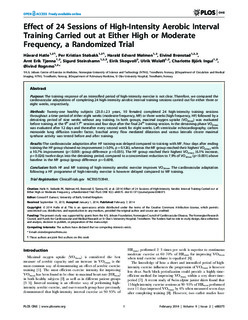| dc.contributor.author | Hatle, Håvard | |
| dc.contributor.author | Støbakk, Per Kristian | |
| dc.contributor.author | Hansen, Harald Edvard Mølmen | |
| dc.contributor.author | Brønstad, Eivind | |
| dc.contributor.author | Tjønna, Arnt Erik | |
| dc.contributor.author | Steinshamn, Sigurd Loe | |
| dc.contributor.author | Skogvoll, Eirik | |
| dc.contributor.author | Wisløff, Ulrik | |
| dc.contributor.author | Ingul, Charlotte Bjørk | |
| dc.contributor.author | Rognmo, Øivind | |
| dc.date.accessioned | 2015-11-24T12:56:02Z | |
| dc.date.accessioned | 2015-12-04T09:38:24Z | |
| dc.date.available | 2015-11-24T12:56:02Z | |
| dc.date.available | 2015-12-04T09:38:24Z | |
| dc.date.issued | 2014 | |
| dc.identifier.citation | PLoS ONE 2014, 9(2) | nb_NO |
| dc.identifier.issn | 1932-6203 | |
| dc.identifier.uri | http://hdl.handle.net/11250/2366906 | |
| dc.description.abstract | Purpose:
The training response of an intensified period of high-intensity exercise is not clear. Therefore, we compared the cardiovascular adaptations of completing 24 high-intensity aerobic interval training sessions carried out for either three or eight weeks, respectively.
Methods:
Twenty-one healthy subjects (23.0±2.1 years, 10 females) completed 24 high-intensity training sessions throughout a time-period of either eight weeks (moderate frequency, MF) or three weeks (high frequency, HF) followed by a detraining period of nine weeks without any training. In both groups, maximal oxygen uptake (VO2max) was evaluated before training, at the 9th and 17th session and four days after the final 24th training session. In the detraining phase VO2max was evaluated after 12 days and thereafter every second week for eight weeks. Left ventricular echocardiography, carbon monoxide lung diffusion transfer factor, brachial artery flow mediated dilatation and vastus lateralis citrate maximal synthase activity was tested before and after training.
Results:
The cardiovascular adaptation after HF training was delayed compared to training with MF. Four days after ending training the HF group showed no improvement (+3.0%, p = 0.126), whereas the MF group reached their highest VO2max with a 10.7% improvement (p<0.001: group difference p = 0.035). The HF group reached their highest VO2max (6.1% increase, p = 0.026) twelve days into the detraining period, compared to a concomitant reduction to 7.9% of VO2max (p<0.001) above baseline in the MF group (group difference p = 0.609).
Conclusion:
Both HF and MF training of high-intensity aerobic exercise improves VO2max. The cardiovascular adaptation following a HF programme of high-intensity exercise is however delayed compared to MF training. | nb_NO |
| dc.language.iso | eng | nb_NO |
| dc.publisher | Public Library of Science | nb_NO |
| dc.title | Effect of 24 sessions of high-intensity aerobic interval training carried out at either high or moderate frequency, a randomized trial | nb_NO |
| dc.type | Journal article | nb_NO |
| dc.type | Peer reviewed | en_GB |
| dc.date.updated | 2015-11-24T12:56:02Z | |
| dc.source.volume | 9 | nb_NO |
| dc.source.journal | PLoS ONE | nb_NO |
| dc.source.issue | 2 | nb_NO |
| dc.identifier.doi | 10.1371/journal.pone.0088375 | |
| dc.identifier.cristin | 1167867 | |
| dc.description.localcode | © 2014 Hatle et al. This is an open-access article distributed under the terms of the Creative Commons Attribution License, which permits unrestricted use, distribution, and reproduction in any medium, provided the original author and source are credited. | nb_NO |
